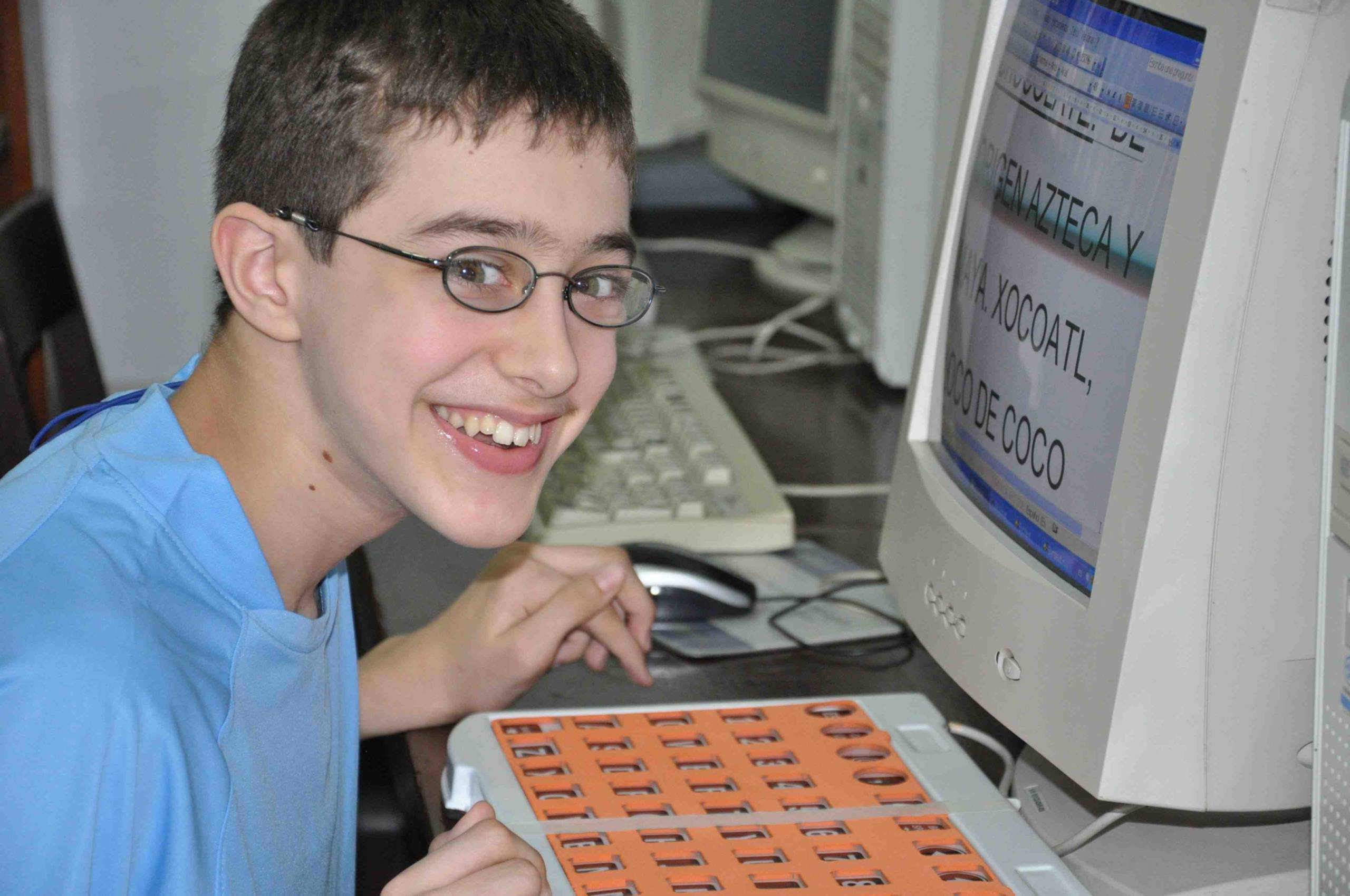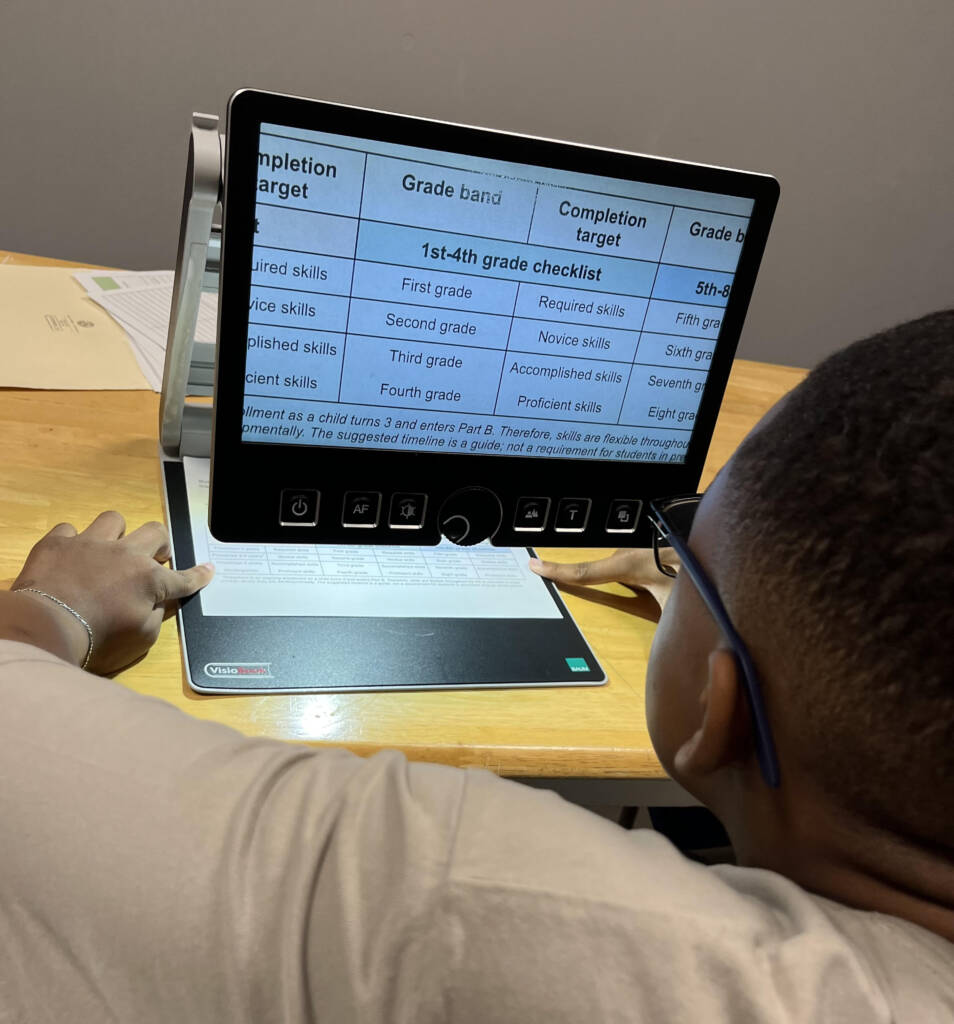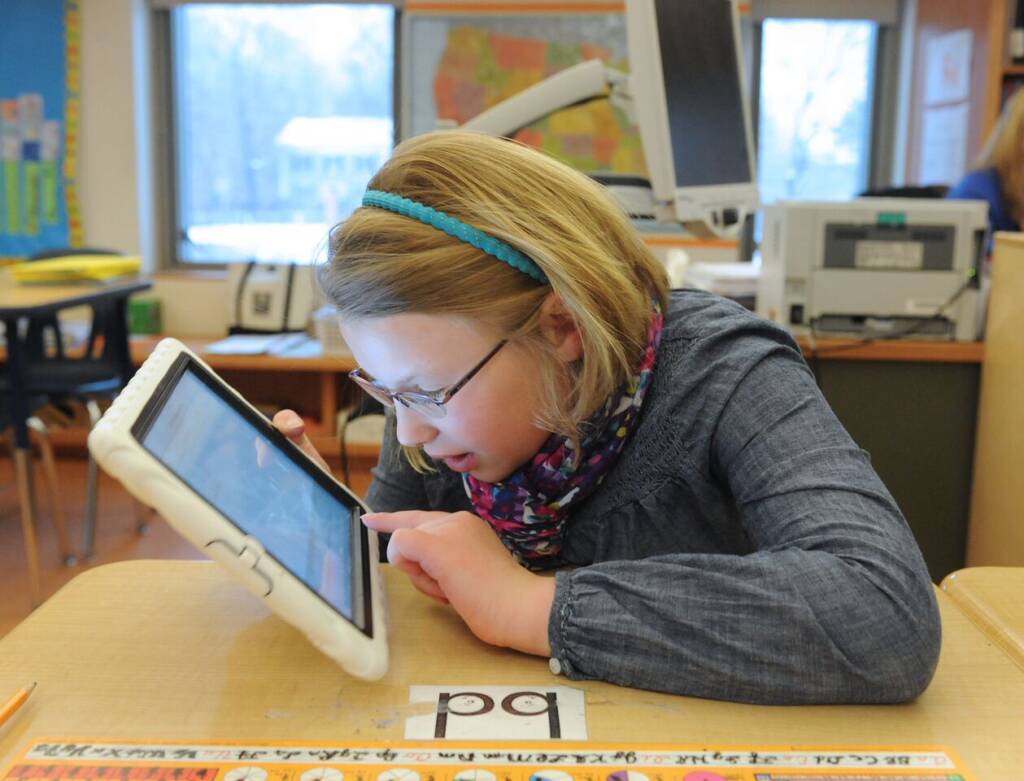This article is designed to help educators to plan strategies and accommodations to improve visual access to the environment for students with Low Vision. Please note that this is an excerpt from a longer article on Low Vision.
Download the full original article.
Strategies and Recommendations for Addressing Low Vision
When working with children with low vision it is important to remember that they have the potential to learn to use their vision in a more efficient way. So, what can teachers do to help them reach their maximum level of visual efficiency?
Teachers and other professionals working with these children have to provide the necessary instruction and environmental modifications to help students maximize their visual ability, develop a positive self-image and greater independence in the classroom and the community.
In the following topics, strategies and recommendations to better address the needs of children with low vision will be presented.
Please note that these are general guidelines and that a child’s Teacher of the Visually Impaired or a Low Vision Specialist should be consulted about specific recommendations for an individual child.
Topics:
- General strategies, activities and materials for students with low vision
- Specific recommendations for students with reduced visual acuity
- Specific recommendations for students with central visual field loss
- Specific recommendations for students with peripheral visual field loss
- Final tips
Topic 1: General strategies, activities and materials for students with low vision
It is important that educators learn to change the environment or alter objects to make them easier to see by their students with low vision. When planning environmental modifications, considerations about lighting, color and contrast, size and distance, and organization of time and space have to be taken into account.
Please remember that even though children with low vision will benefit from the following recommendations, when making specific suggestions to improve vision it is essential to consider the characteristics of the visual impairment (if it causes a reduced visual acuity, a central visual field loss or a peripheral visual field loss).
Subtopic 1.1: Illumination

Some children with low vision are very sensitive to light and glare. Teachers should control the light in the classroom when possible using curtains, maintaining an even amount of light throughout the room, sitting the child with back to windows, reducing the glare on surfaces, and suggesting the child wear a hat/visors or sunglasses even when staying indoors.
Other children need more light and it is recommended to allow the child to position himself near natural light (windows) when possible. When using lamps (if available), they should be placed behind the child’s shoulder, on opposite side of writing hand and/or same side as stronger eye.
Subtopic 1.2: Color and contrast
Children with low vision may benefit from high contrast objects and pictures. For example, the lines on a piece of paper are easier to see if they are highlighted with a black marker. When having lunch, the white utensils are better seen if they are placed on a red or black tray than on a white table. The student will be able to better read his own writing if he uses a thicker black pencil/pen/marker.
Basic principles when using color to create contrast:
- black and white give highest contrast
- do not use dark colors together (like blue and green)
- avoid using white and gray with other light colors
- avoid using pastel colors next to each other
- use bright colored objects for daily life activities
- use masking tape if an object has to be highlighted (like the hanger where the student has to hang his jacket on)
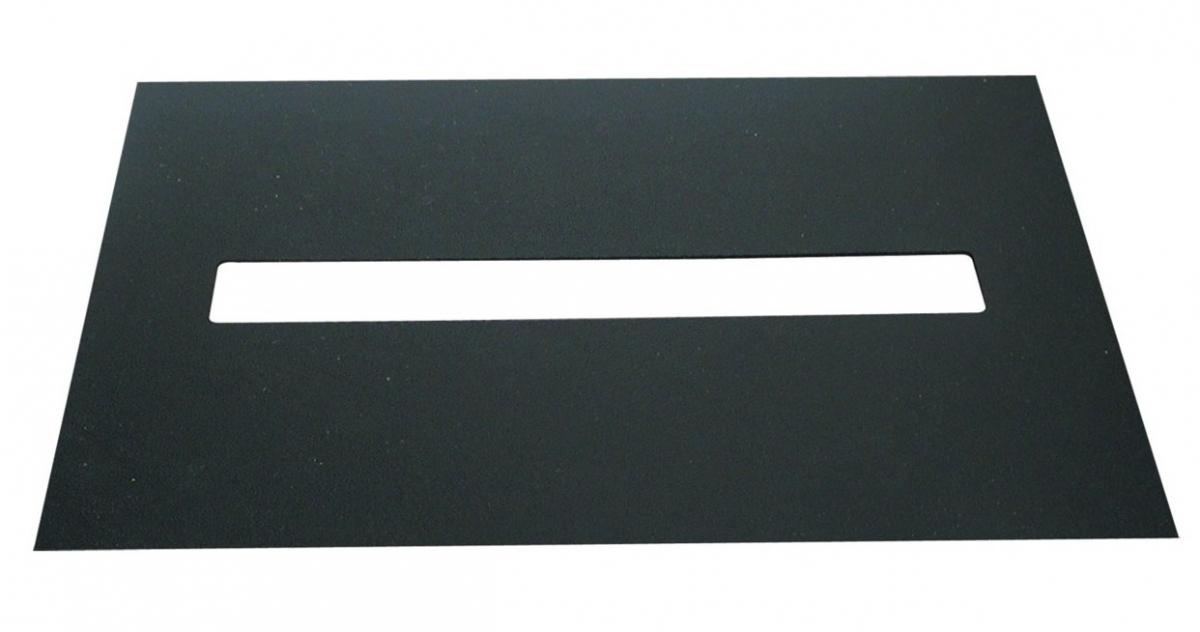 Students may also need a typoscope when reading. This is a reading shield that it can be made of a black material (or cardboard) in which there is a rectangular (cut out) allowing one or more lines of print to be seen. It reduces extra light reflected from the surface of the paper and helps the student to stay on the correct line while reading.
Students may also need a typoscope when reading. This is a reading shield that it can be made of a black material (or cardboard) in which there is a rectangular (cut out) allowing one or more lines of print to be seen. It reduces extra light reflected from the surface of the paper and helps the student to stay on the correct line while reading.
Subtopic 1.3: Size and distance
Children with low vision might also benefit from magnification. Educators can offer their students pictures/images/maps and enlarged print. These children may also prefer to work at close distances. They can be moved closer to the object (sitting closer to the board) or the object can be moved closer to the student (people can get closer when talking).
Subtopic 1.4: Organization of time and space
To reduce the visual clutter in the classroom, educators should:
- remove useless objects in general
- reduce the number of objects in the immediate working area
- use masking tape to improve the color/contrast on doorframes, tabletops, etc.
- spot lights to highlight a particular area
- maintain the place and all the school supplies well organized so the student can easily identify them
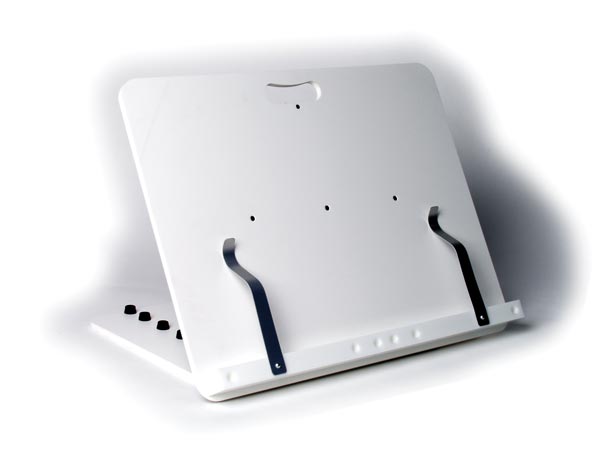 To provide greater physical comfort and encourage appropriate posture, educators can provide their students with: a reading/writing stand, a clip board, a standing lamp and a proper chair/table.
To provide greater physical comfort and encourage appropriate posture, educators can provide their students with: a reading/writing stand, a clip board, a standing lamp and a proper chair/table.
Children with low vision may also benefit from an efficient use of time. Educators can: encourage the child to wear his prescribed glasses (if appropriate) to reduce visual fatigue, propose pre-arranged breaks, allow the student to be visually focused for shorter periods of time, offer more time when visually exploring a material and when concreting a visually challenged task (for example working with a material that hasn’t been adapted to the student’s visual needs).
Topic 2: Specific recommendations for students with reduced visual acuity
These children may benefit from prescribed glasses (if used as recommended by an eye doctor), magnification (enlarged print and images), high contrast materials (like highlighting reading materials, stairs, doorways) and preferential seating (moving closer to object, board, etc.).
If glare sensitivity is an issue (what is usual in cases of reduced visual acuity), educators can eliminate or reposition the source of light, position the child away from source and/or recommend the use of sunglasses and hats (especially out of doors).
If the student has difficulties with distance viewing, teachers can try to familiarize him with the proposed task and environment. If the area is visually simplified (fewer objects are around his visual target) and a visual break is allowed the student may highly increase his visual performance.
Topic 3: Specific recommendations for students with central visual field loss
Children with this kind of vision loss often benefit from the same implemented strategies than in the case of reduced visual acuity (mentioned above).
What is important to highlight is that these particular students may experience incomplete images or a central “blind spot” when looking. For this reason, qualified vision teachers should teach this specific group of children to visually scan, trace and follow objects. Since they also appear not to maintain direct eye contact, it is recommended to have them practice how to turn their eyes to establish direct eye contact and to give them feedback about this when interacting directly. If they also present a reduction of the ability to see differences in color, clothing and frequently used objects should be labeled with their color.
Topic 4: Specific recommendations for students with peripheral visual field loss
Learning to use a white cane by having access to Orientation and Mobility training might be necessary for this group of children. Since they may not be aware of objects or people moving across their path they may need to rely on their other senses to be aware of their environment. Educators can then teach them to use a multi-sensory approach to gather information, which is based on being more aware of not only visual cues, but also tactile and auditory input when travelling.
To help them improve their visual performance, it is also essential to eliminate or reduce extreme changes in illumination and to offer enough time for eyes to adjust to changes in lighting before engaging in activities (for example when entering indoors from outdoors, the child may need more time for their eyes to adjust).
These students may also need additional, glare-free illumination. Ideally, classroom should have good overall lighting supplemented by task lighting (desk/floor lamps, spotlighting). This can also be achieved by proper positioning of the student’s seat.
Topic 5: Final tips
When educators put the above recommendations in place, they offer their students opportunities for more active interaction while motivating them to use their vision in a more efficient way. Presenting meaningful activities, using age- appropriate materials and offering clear information through repetitive routines will always be appreciated by children with low vision.
However, it is important to be aware that these strategies are only intended as suggestions. Children with low vision benefit from specific strategies that consider their particular visual needs. And they will benefit greatly if their teachers start believing that they also can learn despite their reduced, low vision.
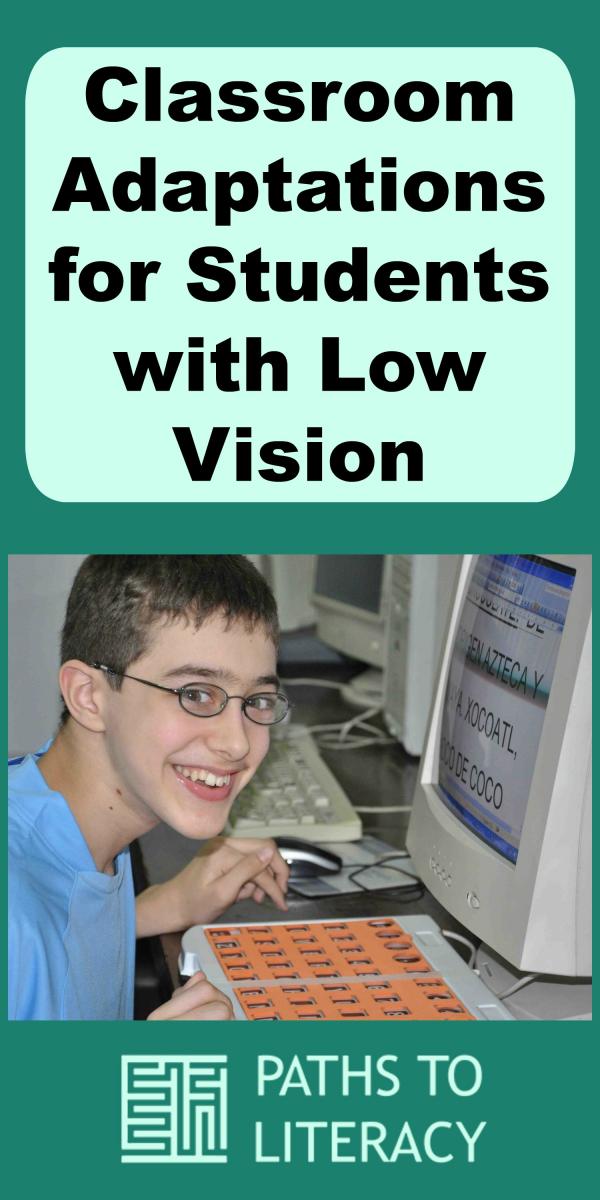
Daniela Gissara is an Optician, a Teacher for the Visually Impaired and a Low Vision Therapist. She has been working with children with low vision for more than 10 years and has provided training for Perkins International in Latin America and Asia. She currently works in the United States as an Educational Specialist for the Educational Leadership Program at Perkins School for the Blind.

